| schema location: | C:\m2mmc\branches\4.4.6\win\unified-web-service\APIs\v2\Schema\DeviceGroupService.xsd |
| attributeFormDefault: | |
| elementFormDefault: | qualified |
| targetNamespace: | http://nphase.com/unifiedwebservice/v2 |
| schema location: | C:\m2mmc\branches\4.4.6\win\unified-web-service\APIs\v2\Schema\Types\DeviceGroupServiceTypes.xsd |
| attributeFormDefault: | |
| elementFormDefault: | qualified |
| targetNamespace: | http://nphase.com/unifiedwebservice/v2 |
| Complex types |
| DeviceGroupInfo |
| schema location: | C:\m2mmc\branches\4.4.6\win\unified-web-service\APIs\v2\Schema\Types\Common\CommonTypes.xsd |
| attributeFormDefault: | |
| elementFormDefault: | qualified |
| targetNamespace: | http://nphase.com/unifiedwebservice/v2 |
element CreateDeviceGroupRequest
| diagram | 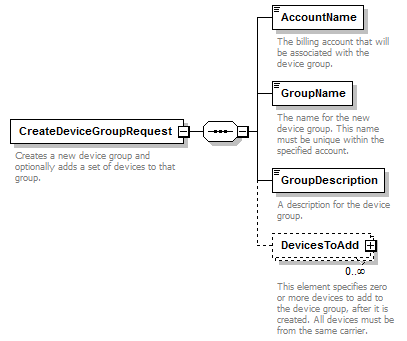 |
||
| namespace | http://nphase.com/unifiedwebservice/v2 | ||
| properties |
|
||
| children | AccountName GroupName GroupDescription DevicesToAdd | ||
| annotation |
|
||
| source | <xs:element name="CreateDeviceGroupRequest"> <xs:annotation> <xs:documentation>Creates a new device group and optionally adds a set of devices to that group.</xs:documentation> </xs:annotation> <xs:complexType> <xs:sequence> <xs:element name="AccountName" type="xs:string"> <xs:annotation> <xs:documentation>The billing account that will be associated with the device group.</xs:documentation> </xs:annotation> </xs:element> <xs:element name="GroupName" type="xs:string"> <xs:annotation> <xs:documentation>The name for the new device group. This name must be unique within the specified account.</xs:documentation> </xs:annotation> </xs:element> <xs:element name="GroupDescription" type="xs:string"> <xs:annotation> <xs:documentation>A description for the device group.</xs:documentation> </xs:annotation> </xs:element> <xs:element name="DevicesToAdd" type="DeviceIdentifier" minOccurs="0" maxOccurs="unbounded"> <xs:annotation> <xs:documentation>This element specifies zero or more devices to add to the device group, after it is created. All devices must be from the same carrier.</xs:documentation> </xs:annotation> </xs:element> </xs:sequence> </xs:complexType> </xs:element> |
element CreateDeviceGroupRequest/AccountName
| diagram |  |
||
| namespace | http://nphase.com/unifiedwebservice/v2 | ||
| type | xs:string | ||
| properties |
|
||
| annotation |
|
||
| source | <xs:element name="AccountName" type="xs:string"> <xs:annotation> <xs:documentation>The billing account that will be associated with the device group.</xs:documentation> </xs:annotation> </xs:element> |
element CreateDeviceGroupRequest/GroupName
| diagram |  |
||
| namespace | http://nphase.com/unifiedwebservice/v2 | ||
| type | xs:string | ||
| properties |
|
||
| annotation |
|
||
| source | <xs:element name="GroupName" type="xs:string"> <xs:annotation> <xs:documentation>The name for the new device group. This name must be unique within the specified account.</xs:documentation> </xs:annotation> </xs:element> |
element CreateDeviceGroupRequest/GroupDescription
| diagram |  |
||
| namespace | http://nphase.com/unifiedwebservice/v2 | ||
| type | xs:string | ||
| properties |
|
||
| annotation |
|
||
| source | <xs:element name="GroupDescription" type="xs:string"> <xs:annotation> <xs:documentation>A description for the device group.</xs:documentation> </xs:annotation> </xs:element> |
element CreateDeviceGroupRequest/DevicesToAdd
| diagram | 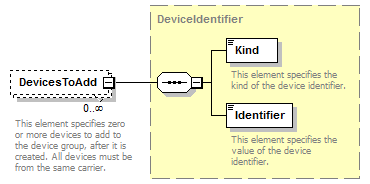 |
||||||
| namespace | http://nphase.com/unifiedwebservice/v2 | ||||||
| type | DeviceIdentifier | ||||||
| properties |
|
||||||
| children | Kind Identifier | ||||||
| annotation |
|
||||||
| source | <xs:element name="DevicesToAdd" type="DeviceIdentifier" minOccurs="0" maxOccurs="unbounded"> <xs:annotation> <xs:documentation>This element specifies zero or more devices to add to the device group, after it is created. All devices must be from the same carrier.</xs:documentation> </xs:annotation> </xs:element> |
element CreateDeviceGroupResponse
| diagram |  |
||
| namespace | http://nphase.com/unifiedwebservice/v2 | ||
| properties |
|
||
| annotation |
|
||
| source | <xs:element name="CreateDeviceGroupResponse"> <xs:annotation> <xs:documentation>Indicates whether or not the device group was successfully created. If the operation was successful, this API provides an empty response object. If the operation failed, the API throws an exception with an error message.</xs:documentation> </xs:annotation> <xs:complexType> <xs:sequence/> </xs:complexType> </xs:element> |
element DeleteDeviceGroupRequest
| diagram | 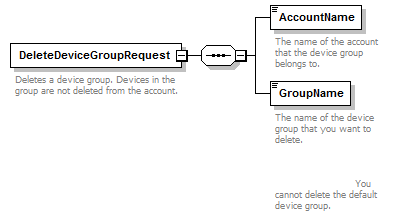 |
||
| namespace | http://nphase.com/unifiedwebservice/v2 | ||
| properties |
|
||
| children | AccountName GroupName | ||
| annotation |
|
||
| source | <xs:element name="DeleteDeviceGroupRequest"> <xs:annotation> <xs:documentation>Deletes a device group. Devices in the group are not deleted from the account.</xs:documentation> </xs:annotation> <xs:complexType> <xs:sequence> <xs:element name="AccountName" type="xs:string"> <xs:annotation> <xs:documentation>The name of the account that the device group belongs to.</xs:documentation> </xs:annotation> </xs:element> <xs:element name="GroupName" type="xs:string"> <xs:annotation> <xs:documentation>The name of the device group that you want to delete. You cannot delete the default device group.</xs:documentation> </xs:annotation> </xs:element> </xs:sequence> </xs:complexType> </xs:element> |
element DeleteDeviceGroupRequest/AccountName
| diagram |  |
||
| namespace | http://nphase.com/unifiedwebservice/v2 | ||
| type | xs:string | ||
| properties |
|
||
| annotation |
|
||
| source | <xs:element name="AccountName" type="xs:string"> <xs:annotation> <xs:documentation>The name of the account that the device group belongs to.</xs:documentation> </xs:annotation> </xs:element> |
element DeleteDeviceGroupRequest/GroupName
| diagram | 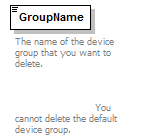 |
||
| namespace | http://nphase.com/unifiedwebservice/v2 | ||
| type | xs:string | ||
| properties |
|
||
| annotation |
|
||
| source | <xs:element name="GroupName" type="xs:string"> <xs:annotation> <xs:documentation>The name of the device group that you want to delete. You cannot delete the default device group.</xs:documentation> </xs:annotation> </xs:element> |
element DeleteDeviceGroupResponse
| diagram |  |
||
| namespace | http://nphase.com/unifiedwebservice/v2 | ||
| properties |
|
||
| annotation |
|
||
| source | <xs:element name="DeleteDeviceGroupResponse"> <xs:annotation> <xs:documentation>An empty response indicates that the device group was deleted successfully. If the operation failed, the API throws an exception with an error message.</xs:documentation> </xs:annotation> <xs:complexType> <xs:sequence/> </xs:complexType> </xs:element> |
element GetDefaultDeviceGroupInformationRequest
| diagram | 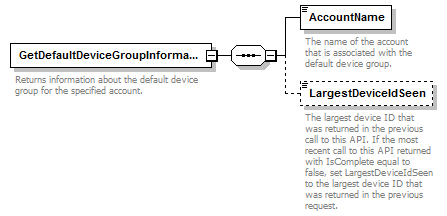 |
||
| namespace | http://nphase.com/unifiedwebservice/v2 | ||
| properties |
|
||
| children | AccountName LargestDeviceIdSeen | ||
| annotation |
|
||
| source | <xs:element name="GetDefaultDeviceGroupInformationRequest"> <xs:annotation> <xs:documentation>Returns information about the default device group for the specified account.</xs:documentation> </xs:annotation> <xs:complexType> <xs:sequence> <xs:element name="AccountName" type="xs:string"> <xs:annotation> <xs:documentation>The name of the account that is associated with the default device group.</xs:documentation> </xs:annotation> </xs:element> <xs:element name="LargestDeviceIdSeen" type="xs:long" nillable="true" minOccurs="0"> <xs:annotation> <xs:documentation>The largest device ID that was returned in the previous call to this API. If the most recent call to this API returned with IsComplete equal to false, set LargestDeviceIdSeen to the largest device ID that was returned in the previous request.</xs:documentation> </xs:annotation> </xs:element> </xs:sequence> </xs:complexType> </xs:element> |
element GetDefaultDeviceGroupInformationRequest/AccountName
| diagram |  |
||
| namespace | http://nphase.com/unifiedwebservice/v2 | ||
| type | xs:string | ||
| properties |
|
||
| annotation |
|
||
| source | <xs:element name="AccountName" type="xs:string"> <xs:annotation> <xs:documentation>The name of the account that is associated with the default device group.</xs:documentation> </xs:annotation> </xs:element> |
element GetDefaultDeviceGroupInformationRequest/LargestDeviceIdSeen
| diagram |  |
||||||||
| namespace | http://nphase.com/unifiedwebservice/v2 | ||||||||
| type | xs:long | ||||||||
| properties |
|
||||||||
| annotation |
|
||||||||
| source | <xs:element name="LargestDeviceIdSeen" type="xs:long" nillable="true" minOccurs="0"> <xs:annotation> <xs:documentation>The largest device ID that was returned in the previous call to this API. If the most recent call to this API returned with IsComplete equal to false, set LargestDeviceIdSeen to the largest device ID that was returned in the previous request.</xs:documentation> </xs:annotation> </xs:element> |
element GetDefaultDeviceGroupInformationResponse
| diagram | 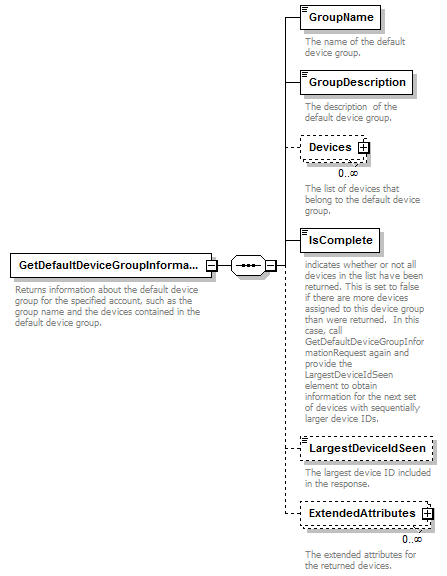 |
||
| namespace | http://nphase.com/unifiedwebservice/v2 | ||
| properties |
|
||
| children | GroupName GroupDescription Devices IsComplete LargestDeviceIdSeen ExtendedAttributes | ||
| annotation |
|
||
| source | <xs:element name="GetDefaultDeviceGroupInformationResponse"> <xs:annotation> <xs:documentation>Returns information about the default device group for the specified account, such as the group name and the devices contained in the default device group.</xs:documentation> </xs:annotation> <xs:complexType> <xs:sequence> <xs:element name="GroupName" type="xs:string"> <xs:annotation> <xs:documentation>The name of the default device group.</xs:documentation> </xs:annotation> </xs:element> <xs:element name="GroupDescription" type="xs:string"> <xs:annotation> <xs:documentation>The description of the default device group.</xs:documentation> </xs:annotation> </xs:element> <xs:element name="Devices" type="DeviceIdentifierCollection" nillable="true" minOccurs="0" maxOccurs="unbounded"> <xs:annotation> <xs:documentation>The list of devices that belong to the default device group.</xs:documentation> </xs:annotation> </xs:element> <xs:element name="IsComplete" type="xs:boolean"> <xs:annotation> <xs:documentation>indicates whether or not all devices in the list have been returned. This is set to false if there are more devices assigned to this device group than were returned. In this case, call GetDefaultDeviceGroupInformationRequest again and provide the LargestDeviceIdSeen element to obtain information for the next set of devices with sequentially larger device IDs.</xs:documentation> </xs:annotation> </xs:element> <xs:element name="LargestDeviceIdSeen" type="xs:long" nillable="true" minOccurs="0"> <xs:annotation> <xs:documentation>The largest device ID included in the response.</xs:documentation> </xs:annotation> </xs:element> <xs:element name="ExtendedAttributes" type="ExtendedAttributesObj" nillable="true" minOccurs="0" maxOccurs="unbounded"> <xs:annotation> <xs:documentation>The extended attributes for the returned devices.</xs:documentation> </xs:annotation> </xs:element> </xs:sequence> </xs:complexType> </xs:element> |
element GetDefaultDeviceGroupInformationResponse/GroupName
| diagram |  |
||
| namespace | http://nphase.com/unifiedwebservice/v2 | ||
| type | xs:string | ||
| properties |
|
||
| annotation |
|
||
| source | <xs:element name="GroupName" type="xs:string"> <xs:annotation> <xs:documentation>The name of the default device group.</xs:documentation> </xs:annotation> </xs:element> |
element GetDefaultDeviceGroupInformationResponse/GroupDescription
| diagram |  |
||
| namespace | http://nphase.com/unifiedwebservice/v2 | ||
| type | xs:string | ||
| properties |
|
||
| annotation |
|
||
| source | <xs:element name="GroupDescription" type="xs:string"> <xs:annotation> <xs:documentation>The description of the default device group.</xs:documentation> </xs:annotation> </xs:element> |
element GetDefaultDeviceGroupInformationResponse/Devices
| diagram | 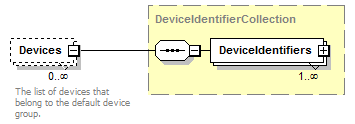 |
||||||||
| namespace | http://nphase.com/unifiedwebservice/v2 | ||||||||
| type | DeviceIdentifierCollection | ||||||||
| properties |
|
||||||||
| children | DeviceIdentifiers | ||||||||
| annotation |
|
||||||||
| source | <xs:element name="Devices" type="DeviceIdentifierCollection" nillable="true" minOccurs="0" maxOccurs="unbounded"> <xs:annotation> <xs:documentation>The list of devices that belong to the default device group.</xs:documentation> </xs:annotation> </xs:element> |
element GetDefaultDeviceGroupInformationResponse/IsComplete
| diagram | 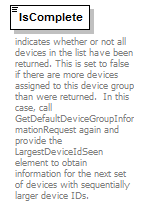 |
||
| namespace | http://nphase.com/unifiedwebservice/v2 | ||
| type | xs:boolean | ||
| properties |
|
||
| annotation |
|
||
| source | <xs:element name="IsComplete" type="xs:boolean"> <xs:annotation> <xs:documentation>indicates whether or not all devices in the list have been returned. This is set to false if there are more devices assigned to this device group than were returned. In this case, call GetDefaultDeviceGroupInformationRequest again and provide the LargestDeviceIdSeen element to obtain information for the next set of devices with sequentially larger device IDs.</xs:documentation> </xs:annotation> </xs:element> |
element GetDefaultDeviceGroupInformationResponse/LargestDeviceIdSeen
| diagram |  |
||||||||
| namespace | http://nphase.com/unifiedwebservice/v2 | ||||||||
| type | xs:long | ||||||||
| properties |
|
||||||||
| annotation |
|
||||||||
| source | <xs:element name="LargestDeviceIdSeen" type="xs:long" nillable="true" minOccurs="0"> <xs:annotation> <xs:documentation>The largest device ID included in the response.</xs:documentation> </xs:annotation> </xs:element> |
element GetDefaultDeviceGroupInformationResponse/ExtendedAttributes
| diagram |  |
||||||||
| namespace | http://nphase.com/unifiedwebservice/v2 | ||||||||
| type | ExtendedAttributesObj | ||||||||
| properties |
|
||||||||
| children | Key Value | ||||||||
| annotation |
|
||||||||
| source | <xs:element name="ExtendedAttributes" type="ExtendedAttributesObj" nillable="true" minOccurs="0" maxOccurs="unbounded"> <xs:annotation> <xs:documentation>The extended attributes for the returned devices.</xs:documentation> </xs:annotation> </xs:element> |
element GetDeviceGroupInformationRequest
| diagram | 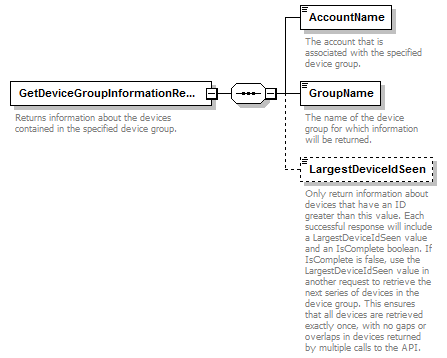 |
||
| namespace | http://nphase.com/unifiedwebservice/v2 | ||
| properties |
|
||
| children | AccountName GroupName LargestDeviceIdSeen | ||
| annotation |
|
||
| source | <xs:element name="GetDeviceGroupInformationRequest"> <xs:annotation> <xs:documentation>Returns information about the devices contained in the specified device group.</xs:documentation> </xs:annotation> <xs:complexType> <xs:sequence> <xs:element name="AccountName" type="xs:string"> <xs:annotation> <xs:documentation>The account that is associated with the specified device group.</xs:documentation> </xs:annotation> </xs:element> <xs:element name="GroupName" type="xs:string"> <xs:annotation> <xs:documentation>The name of the device group for which information will be returned.</xs:documentation> </xs:annotation> </xs:element> <xs:element name="LargestDeviceIdSeen" type="xs:long" nillable="true" minOccurs="0"> <xs:annotation> <xs:documentation>Only return information about devices that have an ID greater than this value. Each successful response will include a LargestDeviceIdSeen value and an IsComplete boolean. If IsComplete is false, use the LargestDeviceIdSeen value in another request to retrieve the next series of devices in the device group. This ensures that all devices are retrieved exactly once, with no gaps or overlaps in devices returned by multiple calls to the API.</xs:documentation> </xs:annotation> </xs:element> </xs:sequence> </xs:complexType> </xs:element> |
element GetDeviceGroupInformationRequest/AccountName
| diagram |  |
||
| namespace | http://nphase.com/unifiedwebservice/v2 | ||
| type | xs:string | ||
| properties |
|
||
| annotation |
|
||
| source | <xs:element name="AccountName" type="xs:string"> <xs:annotation> <xs:documentation>The account that is associated with the specified device group.</xs:documentation> </xs:annotation> </xs:element> |
element GetDeviceGroupInformationRequest/GroupName
| diagram |  |
||
| namespace | http://nphase.com/unifiedwebservice/v2 | ||
| type | xs:string | ||
| properties |
|
||
| annotation |
|
||
| source | <xs:element name="GroupName" type="xs:string"> <xs:annotation> <xs:documentation>The name of the device group for which information will be returned.</xs:documentation> </xs:annotation> </xs:element> |
element GetDeviceGroupInformationRequest/LargestDeviceIdSeen
| diagram | 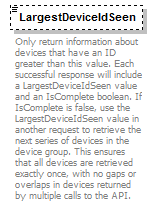 |
||||||||
| namespace | http://nphase.com/unifiedwebservice/v2 | ||||||||
| type | xs:long | ||||||||
| properties |
|
||||||||
| annotation |
|
||||||||
| source | <xs:element name="LargestDeviceIdSeen" type="xs:long" nillable="true" minOccurs="0"> <xs:annotation> <xs:documentation>Only return information about devices that have an ID greater than this value. Each successful response will include a LargestDeviceIdSeen value and an IsComplete boolean. If IsComplete is false, use the LargestDeviceIdSeen value in another request to retrieve the next series of devices in the device group. This ensures that all devices are retrieved exactly once, with no gaps or overlaps in devices returned by multiple calls to the API.</xs:documentation> </xs:annotation> </xs:element> |
element GetDeviceGroupInformationResponse
| diagram | 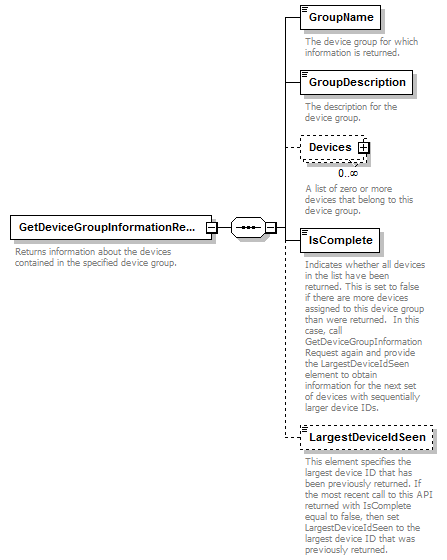 |
||
| namespace | http://nphase.com/unifiedwebservice/v2 | ||
| properties |
|
||
| children | GroupName GroupDescription Devices IsComplete LargestDeviceIdSeen | ||
| annotation |
|
||
| source | <xs:element name="GetDeviceGroupInformationResponse"> <xs:annotation> <xs:documentation>Returns information about the devices contained in the specified device group.</xs:documentation> </xs:annotation> <xs:complexType> <xs:sequence> <xs:element name="GroupName" type="xs:string"> <xs:annotation> <xs:documentation>The device group for which information is returned.</xs:documentation> </xs:annotation> </xs:element> <xs:element name="GroupDescription" type="xs:string"> <xs:annotation> <xs:documentation>The description for the device group.</xs:documentation> </xs:annotation> </xs:element> <xs:element name="Devices" type="DeviceIdentifierCollection" nillable="true" minOccurs="0" maxOccurs="unbounded"> <xs:annotation> <xs:documentation>A list of zero or more devices that belong to this device group.</xs:documentation> </xs:annotation> </xs:element> <xs:element name="IsComplete" type="xs:boolean"> <xs:annotation> <xs:documentation>Indicates whether all devices in the list have been returned. This is set to false if there are more devices assigned to this device group than were returned. In this case, call GetDeviceGroupInformationRequest again and provide the LargestDeviceIdSeen element to obtain information for the next set of devices with sequentially larger device IDs.</xs:documentation> </xs:annotation> </xs:element> <xs:element name="LargestDeviceIdSeen" type="xs:long" nillable="true" minOccurs="0"> <xs:annotation> <xs:documentation>This element specifies the largest device ID that has been previously returned. If the most recent call to this API returned with IsComplete equal to false, then set LargestDeviceIdSeen to the largest device ID that was previously returned.</xs:documentation> </xs:annotation> </xs:element> </xs:sequence> </xs:complexType> </xs:element> |
element GetDeviceGroupInformationResponse/GroupName
| diagram |  |
||
| namespace | http://nphase.com/unifiedwebservice/v2 | ||
| type | xs:string | ||
| properties |
|
||
| annotation |
|
||
| source | <xs:element name="GroupName" type="xs:string"> <xs:annotation> <xs:documentation>The device group for which information is returned.</xs:documentation> </xs:annotation> </xs:element> |
element GetDeviceGroupInformationResponse/GroupDescription
| diagram |  |
||
| namespace | http://nphase.com/unifiedwebservice/v2 | ||
| type | xs:string | ||
| properties |
|
||
| annotation |
|
||
| source | <xs:element name="GroupDescription" type="xs:string"> <xs:annotation> <xs:documentation>The description for the device group.</xs:documentation> </xs:annotation> </xs:element> |
element GetDeviceGroupInformationResponse/Devices
| diagram | 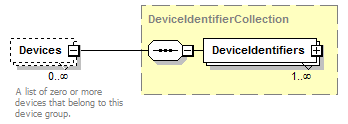 |
||||||||
| namespace | http://nphase.com/unifiedwebservice/v2 | ||||||||
| type | DeviceIdentifierCollection | ||||||||
| properties |
|
||||||||
| children | DeviceIdentifiers | ||||||||
| annotation |
|
||||||||
| source | <xs:element name="Devices" type="DeviceIdentifierCollection" nillable="true" minOccurs="0" maxOccurs="unbounded"> <xs:annotation> <xs:documentation>A list of zero or more devices that belong to this device group.</xs:documentation> </xs:annotation> </xs:element> |
element GetDeviceGroupInformationResponse/IsComplete
| diagram | 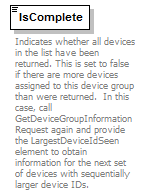 |
||
| namespace | http://nphase.com/unifiedwebservice/v2 | ||
| type | xs:boolean | ||
| properties |
|
||
| annotation |
|
||
| source | <xs:element name="IsComplete" type="xs:boolean"> <xs:annotation> <xs:documentation>Indicates whether all devices in the list have been returned. This is set to false if there are more devices assigned to this device group than were returned. In this case, call GetDeviceGroupInformationRequest again and provide the LargestDeviceIdSeen element to obtain information for the next set of devices with sequentially larger device IDs.</xs:documentation> </xs:annotation> </xs:element> |
element GetDeviceGroupInformationResponse/LargestDeviceIdSeen
| diagram | 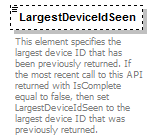 |
||||||||
| namespace | http://nphase.com/unifiedwebservice/v2 | ||||||||
| type | xs:long | ||||||||
| properties |
|
||||||||
| annotation |
|
||||||||
| source | <xs:element name="LargestDeviceIdSeen" type="xs:long" nillable="true" minOccurs="0"> <xs:annotation> <xs:documentation>This element specifies the largest device ID that has been previously returned. If the most recent call to this API returned with IsComplete equal to false, then set LargestDeviceIdSeen to the largest device ID that was previously returned.</xs:documentation> </xs:annotation> </xs:element> |
element GetDeviceGroupListRequest
| diagram |  |
||
| namespace | http://nphase.com/unifiedwebservice/v2 | ||
| properties |
|
||
| children | AccountName PageIndex PageSize | ||
| annotation |
|
||
| source | <xs:element name="GetDeviceGroupListRequest"> <xs:annotation> <xs:documentation>Returns a list of all device groups in a specified account.</xs:documentation> </xs:annotation> <xs:complexType> <xs:sequence> <xs:element name="AccountName" type="xs:string"> <xs:annotation> <xs:documentation>The account for which to retrieve the list of device groups.</xs:documentation> </xs:annotation> </xs:element> <xs:element name="PageIndex" type="xs:int" nillable="true" minOccurs="0"> <xs:annotation> <xs:documentation>Which "page" of the total list of device groups you want returned in the response, based on the PageSize value.</xs:documentation> </xs:annotation> </xs:element> <xs:element name="PageSize" type="xs:int" nillable="true" minOccurs="0"> <xs:annotation> <xs:documentation>The number of device groups that you want returned in each response. Must be between 1 and 500. The default value is 500. </xs:documentation> </xs:annotation> </xs:element> </xs:sequence> </xs:complexType> </xs:element> |
element GetDeviceGroupListRequest/AccountName
| diagram |  |
||
| namespace | http://nphase.com/unifiedwebservice/v2 | ||
| type | xs:string | ||
| properties |
|
||
| annotation |
|
||
| source | <xs:element name="AccountName" type="xs:string"> <xs:annotation> <xs:documentation>The account for which to retrieve the list of device groups.</xs:documentation> </xs:annotation> </xs:element> |
element GetDeviceGroupListRequest/PageIndex
| diagram |  |
||||||||
| namespace | http://nphase.com/unifiedwebservice/v2 | ||||||||
| type | xs:int | ||||||||
| properties |
|
||||||||
| annotation |
|
||||||||
| source | <xs:element name="PageIndex" type="xs:int" nillable="true" minOccurs="0"> <xs:annotation> <xs:documentation>Which "page" of the total list of device groups you want returned in the response, based on the PageSize value.</xs:documentation> </xs:annotation> </xs:element> |
element GetDeviceGroupListRequest/PageSize
| diagram |  |
||||||||
| namespace | http://nphase.com/unifiedwebservice/v2 | ||||||||
| type | xs:int | ||||||||
| properties |
|
||||||||
| annotation |
|
||||||||
| source | <xs:element name="PageSize" type="xs:int" nillable="true" minOccurs="0"> <xs:annotation> <xs:documentation>The number of device groups that you want returned in each response. Must be between 1 and 500. The default value is 500. </xs:documentation> </xs:annotation> </xs:element> |
element GetDeviceGroupListResponse
| diagram |  |
||
| namespace | http://nphase.com/unifiedwebservice/v2 | ||
| properties |
|
||
| children | DeviceGroupList | ||
| annotation |
|
||
| source | <xs:element name="GetDeviceGroupListResponse"> <xs:annotation> <xs:documentation>Returns a list of all device groups for a specified account.</xs:documentation> </xs:annotation> <xs:complexType> <xs:sequence> <xs:element name="DeviceGroupList" type="DeviceGroupInfo" minOccurs="0" maxOccurs="unbounded"> <xs:annotation> <xs:documentation>A list of device groups associated with the specified account.</xs:documentation> </xs:annotation> </xs:element> </xs:sequence> </xs:complexType> </xs:element> |
element GetDeviceGroupListResponse/DeviceGroupList
| diagram | 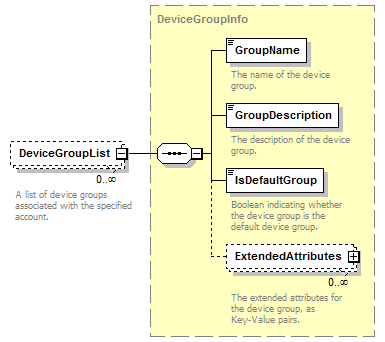 |
||||||
| namespace | http://nphase.com/unifiedwebservice/v2 | ||||||
| type | DeviceGroupInfo | ||||||
| properties |
|
||||||
| children | GroupName GroupDescription IsDefaultGroup ExtendedAttributes | ||||||
| annotation |
|
||||||
| source | <xs:element name="DeviceGroupList" type="DeviceGroupInfo" minOccurs="0" maxOccurs="unbounded"> <xs:annotation> <xs:documentation>A list of device groups associated with the specified account.</xs:documentation> </xs:annotation> </xs:element> |
element UpdateDeviceGroupRequest
| diagram | 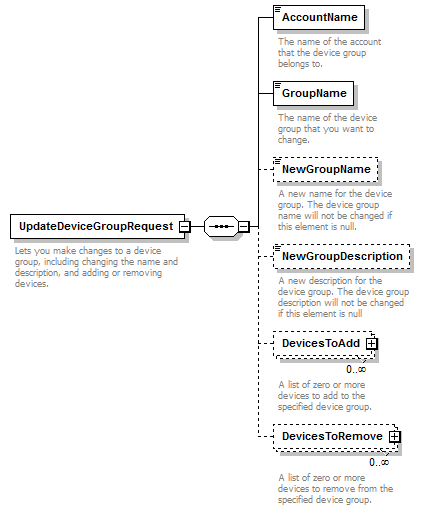 |
||
| namespace | http://nphase.com/unifiedwebservice/v2 | ||
| properties |
|
||
| children | AccountName GroupName NewGroupName NewGroupDescription DevicesToAdd DevicesToRemove | ||
| annotation |
|
||
| source | <xs:element name="UpdateDeviceGroupRequest"> <xs:annotation> <xs:documentation>Lets you make changes to a device group, including changing the name and description, and adding or removing devices. </xs:documentation> </xs:annotation> <xs:complexType> <xs:sequence> <xs:element name="AccountName" type="xs:string"> <xs:annotation> <xs:documentation>The name of the account that the device group belongs to.</xs:documentation> </xs:annotation> </xs:element> <xs:element name="GroupName" type="xs:string"> <xs:annotation> <xs:documentation>The name of the device group that you want to change.</xs:documentation> </xs:annotation> </xs:element> <xs:element name="NewGroupName" type="xs:string" nillable="true" minOccurs="0"> <xs:annotation> <xs:documentation>A new name for the device group. The device group name will not be changed if this element is null.</xs:documentation> </xs:annotation> </xs:element> <xs:element name="NewGroupDescription" type="xs:string" nillable="true" minOccurs="0"> <xs:annotation> <xs:documentation>A new description for the device group. The device group description will not be changed if this element is null</xs:documentation> </xs:annotation> </xs:element> <xs:element name="DevicesToAdd" type="DeviceIdentifier" nillable="true" minOccurs="0" maxOccurs="unbounded"> <xs:annotation> <xs:documentation>A list of zero or more devices to add to the specified device group.</xs:documentation> </xs:annotation> </xs:element> <xs:element name="DevicesToRemove" type="DeviceIdentifier" nillable="true" minOccurs="0" maxOccurs="unbounded"> <xs:annotation> <xs:documentation>A list of zero or more devices to remove from the specified device group.</xs:documentation> </xs:annotation> </xs:element> </xs:sequence> </xs:complexType> </xs:element> |
element UpdateDeviceGroupRequest/AccountName
| diagram |  |
||
| namespace | http://nphase.com/unifiedwebservice/v2 | ||
| type | xs:string | ||
| properties |
|
||
| annotation |
|
||
| source | <xs:element name="AccountName" type="xs:string"> <xs:annotation> <xs:documentation>The name of the account that the device group belongs to.</xs:documentation> </xs:annotation> </xs:element> |
element UpdateDeviceGroupRequest/GroupName
| diagram |  |
||
| namespace | http://nphase.com/unifiedwebservice/v2 | ||
| type | xs:string | ||
| properties |
|
||
| annotation |
|
||
| source | <xs:element name="GroupName" type="xs:string"> <xs:annotation> <xs:documentation>The name of the device group that you want to change.</xs:documentation> </xs:annotation> </xs:element> |
element UpdateDeviceGroupRequest/NewGroupName
| diagram |  |
||||||||
| namespace | http://nphase.com/unifiedwebservice/v2 | ||||||||
| type | xs:string | ||||||||
| properties |
|
||||||||
| annotation |
|
||||||||
| source | <xs:element name="NewGroupName" type="xs:string" nillable="true" minOccurs="0"> <xs:annotation> <xs:documentation>A new name for the device group. The device group name will not be changed if this element is null.</xs:documentation> </xs:annotation> </xs:element> |
element UpdateDeviceGroupRequest/NewGroupDescription
| diagram |  |
||||||||
| namespace | http://nphase.com/unifiedwebservice/v2 | ||||||||
| type | xs:string | ||||||||
| properties |
|
||||||||
| annotation |
|
||||||||
| source | <xs:element name="NewGroupDescription" type="xs:string" nillable="true" minOccurs="0"> <xs:annotation> <xs:documentation>A new description for the device group. The device group description will not be changed if this element is null</xs:documentation> </xs:annotation> </xs:element> |
element UpdateDeviceGroupRequest/DevicesToAdd
| diagram | 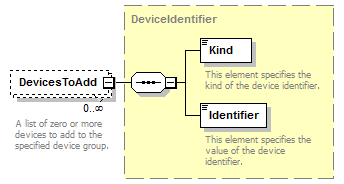 |
||||||||
| namespace | http://nphase.com/unifiedwebservice/v2 | ||||||||
| type | DeviceIdentifier | ||||||||
| properties |
|
||||||||
| children | Kind Identifier | ||||||||
| annotation |
|
||||||||
| source | <xs:element name="DevicesToAdd" type="DeviceIdentifier" nillable="true" minOccurs="0" maxOccurs="unbounded"> <xs:annotation> <xs:documentation>A list of zero or more devices to add to the specified device group.</xs:documentation> </xs:annotation> </xs:element> |
element UpdateDeviceGroupRequest/DevicesToRemove
| diagram | 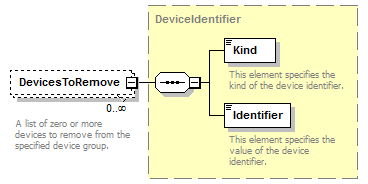 |
||||||||
| namespace | http://nphase.com/unifiedwebservice/v2 | ||||||||
| type | DeviceIdentifier | ||||||||
| properties |
|
||||||||
| children | Kind Identifier | ||||||||
| annotation |
|
||||||||
| source | <xs:element name="DevicesToRemove" type="DeviceIdentifier" nillable="true" minOccurs="0" maxOccurs="unbounded"> <xs:annotation> <xs:documentation>A list of zero or more devices to remove from the specified device group.</xs:documentation> </xs:annotation> </xs:element> |
element UpdateDeviceGroupResponse
| diagram |  |
||
| namespace | http://nphase.com/unifiedwebservice/v2 | ||
| properties |
|
||
| annotation |
|
||
| source | <xs:element name="UpdateDeviceGroupResponse"> <xs:annotation> <xs:documentation>An empty response indicates that the device group was updated successfully. If the operation failed, the API throws an exception with an error message.</xs:documentation> </xs:annotation> <xs:complexType> <xs:sequence/> </xs:complexType> </xs:element> |
complexType DeviceGroupInfo
| diagram | 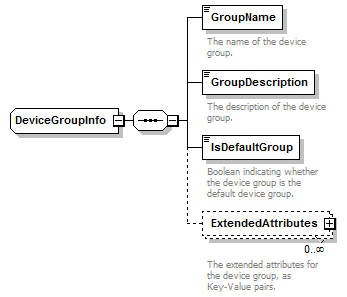 |
||
| namespace | http://nphase.com/unifiedwebservice/v2 | ||
| children | GroupName GroupDescription IsDefaultGroup ExtendedAttributes | ||
| used by |
|
||
| source | <xs:complexType name="DeviceGroupInfo"> <xs:sequence> <xs:element name="GroupName" type="xs:string"> <xs:annotation> <xs:documentation>The name of the device group.</xs:documentation> </xs:annotation> </xs:element> <xs:element name="GroupDescription" type="xs:string"> <xs:annotation> <xs:documentation>The description of the device group.</xs:documentation> </xs:annotation> </xs:element> <xs:element name="IsDefaultGroup" type="xs:boolean"> <xs:annotation> <xs:documentation>Boolean indicating whether the device group is the default device group.</xs:documentation> </xs:annotation> </xs:element> <xs:element name="ExtendedAttributes" type="ExtendedAttributesObj" nillable="true" minOccurs="0" maxOccurs="unbounded"> <xs:annotation> <xs:documentation>The extended attributes for the device group, as Key-Value pairs.</xs:documentation> </xs:annotation> </xs:element> </xs:sequence> </xs:complexType> |
element DeviceGroupInfo/GroupName
| diagram |  |
||
| namespace | http://nphase.com/unifiedwebservice/v2 | ||
| type | xs:string | ||
| properties |
|
||
| annotation |
|
||
| source | <xs:element name="GroupName" type="xs:string"> <xs:annotation> <xs:documentation>The name of the device group.</xs:documentation> </xs:annotation> </xs:element> |
element DeviceGroupInfo/GroupDescription
| diagram |  |
||
| namespace | http://nphase.com/unifiedwebservice/v2 | ||
| type | xs:string | ||
| properties |
|
||
| annotation |
|
||
| source | <xs:element name="GroupDescription" type="xs:string"> <xs:annotation> <xs:documentation>The description of the device group.</xs:documentation> </xs:annotation> </xs:element> |
element DeviceGroupInfo/IsDefaultGroup
| diagram |  |
||
| namespace | http://nphase.com/unifiedwebservice/v2 | ||
| type | xs:boolean | ||
| properties |
|
||
| annotation |
|
||
| source | <xs:element name="IsDefaultGroup" type="xs:boolean"> <xs:annotation> <xs:documentation>Boolean indicating whether the device group is the default device group.</xs:documentation> </xs:annotation> </xs:element> |
element DeviceGroupInfo/ExtendedAttributes
| diagram | 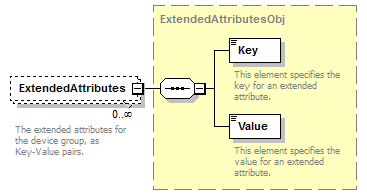 |
||||||||
| namespace | http://nphase.com/unifiedwebservice/v2 | ||||||||
| type | ExtendedAttributesObj | ||||||||
| properties |
|
||||||||
| children | Key Value | ||||||||
| annotation |
|
||||||||
| source | <xs:element name="ExtendedAttributes" type="ExtendedAttributesObj" nillable="true" minOccurs="0" maxOccurs="unbounded"> <xs:annotation> <xs:documentation>The extended attributes for the device group, as Key-Value pairs.</xs:documentation> </xs:annotation> </xs:element> |
complexType CustomFieldFilterObj
| diagram | 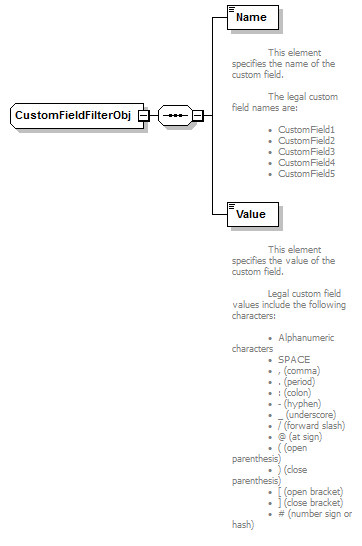 |
| namespace | http://nphase.com/unifiedwebservice/v2 |
| children | Name Value |
| source | <xs:complexType name="CustomFieldFilterObj"> <xs:sequence> <xs:element name="Name" type="xs:string"> <xs:annotation> <xs:documentation> This element specifies the name of the custom field. The legal custom field names are: • CustomField1 • CustomField2 • CustomField3 • CustomField4 • CustomField5 </xs:documentation> </xs:annotation> </xs:element> <xs:element name="Value" type="xs:string"> <xs:annotation> <xs:documentation> This element specifies the value of the custom field. Legal custom field values include the following characters: • Alphanumeric characters • SPACE • , (comma) • . (period) • : (colon) • - (hyphen) • _ (underscore) • / (forward slash) • @ (at sign) • ( (open parenthesis) • ) (close parenthesis) • [ (open bracket) • ] (close bracket) • # (number sign or hash) </xs:documentation> </xs:annotation> </xs:element> </xs:sequence> </xs:complexType> |
element CustomFieldFilterObj/Name
| diagram | 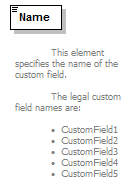 |
||
| namespace | http://nphase.com/unifiedwebservice/v2 | ||
| type | xs:string | ||
| properties |
|
||
| annotation |
|
||
| source | <xs:element name="Name" type="xs:string"> <xs:annotation> <xs:documentation> This element specifies the name of the custom field. The legal custom field names are: • CustomField1 • CustomField2 • CustomField3 • CustomField4 • CustomField5 </xs:documentation> </xs:annotation> </xs:element> |
element CustomFieldFilterObj/Value
| diagram |  |
||
| namespace | http://nphase.com/unifiedwebservice/v2 | ||
| type | xs:string | ||
| properties |
|
||
| annotation |
|
||
| source | <xs:element name="Value" type="xs:string"> <xs:annotation> <xs:documentation> This element specifies the value of the custom field. Legal custom field values include the following characters: • Alphanumeric characters • SPACE • , (comma) • . (period) • : (colon) • - (hyphen) • _ (underscore) • / (forward slash) • @ (at sign) • ( (open parenthesis) • ) (close parenthesis) • [ (open bracket) • ] (close bracket) • # (number sign or hash) </xs:documentation> </xs:annotation> </xs:element> |
complexType Date
| diagram | 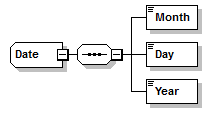 |
| namespace | http://nphase.com/unifiedwebservice/v2 |
| children | Month Day Year |
| source | <xs:complexType name="Date"> <xs:sequence> <xs:element name="Month" type="xs:unsignedByte"/> <xs:element name="Day" type="xs:unsignedByte"/> <xs:element name="Year" type="xs:unsignedShort"/> </xs:sequence> </xs:complexType> |
element Date/Month
| diagram |  |
||
| namespace | http://nphase.com/unifiedwebservice/v2 | ||
| type | xs:unsignedByte | ||
| properties |
|
||
| source | <xs:element name="Month" type="xs:unsignedByte"/> |
element Date/Day
| diagram |  |
||
| namespace | http://nphase.com/unifiedwebservice/v2 | ||
| type | xs:unsignedByte | ||
| properties |
|
||
| source | <xs:element name="Day" type="xs:unsignedByte"/> |
element Date/Year
| diagram |  |
||
| namespace | http://nphase.com/unifiedwebservice/v2 | ||
| type | xs:unsignedShort | ||
| properties |
|
||
| source | <xs:element name="Year" type="xs:unsignedShort"/> |
complexType DeviceIdentifier
| diagram | 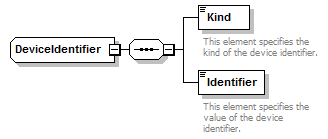 |
||
| namespace | http://nphase.com/unifiedwebservice/v2 | ||
| children | Kind Identifier | ||
| used by |
|
||
| source | <xs:complexType name="DeviceIdentifier"> <xs:sequence> <xs:element name="Kind"> <xs:annotation> <xs:documentation>This element specifies the kind of the device identifier.</xs:documentation> </xs:annotation> <xs:simpleType> <xs:restriction base="xs:string"> <xs:enumeration value="Esn"> <xs:annotation> <xs:documentation>Electronic Serial Number (8-digit hexadecimal or 11-digit decimal format).</xs:documentation> </xs:annotation> </xs:enumeration> <xs:enumeration value="Iccid"> <xs:annotation> <xs:documentation>Integrated Circuit Card ID (used with a SIM card).</xs:documentation> </xs:annotation> </xs:enumeration> <xs:enumeration value="Imsi"> <xs:annotation> <xs:documentation>International Mobile Subscriber Identity</xs:documentation> </xs:annotation> </xs:enumeration> <xs:enumeration value="Mdn"> <xs:annotation> <xs:documentation>Mobile Directory Number</xs:documentation> </xs:annotation> </xs:enumeration> <xs:enumeration value="Meid"> <xs:annotation> <xs:documentation>Mobile Equipment Identifier</xs:documentation> </xs:annotation> </xs:enumeration> <xs:enumeration value="Imei"> <xs:annotation> <xs:documentation>International Mobile Station Equipment Identity</xs:documentation> </xs:annotation> </xs:enumeration> <xs:enumeration value="Msisdn"> <xs:annotation> <xs:documentation>Mobile Subscriber Integrated Services Digital Network-Number</xs:documentation> </xs:annotation> </xs:enumeration> </xs:restriction> </xs:simpleType> </xs:element> <xs:element name="Identifier" type="xs:string"> <xs:annotation> <xs:documentation>This element specifies the value of the device identifier.</xs:documentation> </xs:annotation> </xs:element> </xs:sequence> </xs:complexType> |
element DeviceIdentifier/Kind
| diagram |  |
||||||||||||||||||||||||||||||||||||||
| namespace | http://nphase.com/unifiedwebservice/v2 | ||||||||||||||||||||||||||||||||||||||
| type | restriction of xs:string | ||||||||||||||||||||||||||||||||||||||
| properties |
|
||||||||||||||||||||||||||||||||||||||
| facets |
|
||||||||||||||||||||||||||||||||||||||
| annotation |
|
||||||||||||||||||||||||||||||||||||||
| source | <xs:element name="Kind"> <xs:annotation> <xs:documentation>This element specifies the kind of the device identifier.</xs:documentation> </xs:annotation> <xs:simpleType> <xs:restriction base="xs:string"> <xs:enumeration value="Esn"> <xs:annotation> <xs:documentation>Electronic Serial Number (8-digit hexadecimal or 11-digit decimal format).</xs:documentation> </xs:annotation> </xs:enumeration> <xs:enumeration value="Iccid"> <xs:annotation> <xs:documentation>Integrated Circuit Card ID (used with a SIM card).</xs:documentation> </xs:annotation> </xs:enumeration> <xs:enumeration value="Imsi"> <xs:annotation> <xs:documentation>International Mobile Subscriber Identity</xs:documentation> </xs:annotation> </xs:enumeration> <xs:enumeration value="Mdn"> <xs:annotation> <xs:documentation>Mobile Directory Number</xs:documentation> </xs:annotation> </xs:enumeration> <xs:enumeration value="Meid"> <xs:annotation> <xs:documentation>Mobile Equipment Identifier</xs:documentation> </xs:annotation> </xs:enumeration> <xs:enumeration value="Imei"> <xs:annotation> <xs:documentation>International Mobile Station Equipment Identity</xs:documentation> </xs:annotation> </xs:enumeration> <xs:enumeration value="Msisdn"> <xs:annotation> <xs:documentation>Mobile Subscriber Integrated Services Digital Network-Number</xs:documentation> </xs:annotation> </xs:enumeration> </xs:restriction> </xs:simpleType> </xs:element> |
element DeviceIdentifier/Identifier
| diagram |  |
||
| namespace | http://nphase.com/unifiedwebservice/v2 | ||
| type | xs:string | ||
| properties |
|
||
| annotation |
|
||
| source | <xs:element name="Identifier" type="xs:string"> <xs:annotation> <xs:documentation>This element specifies the value of the device identifier.</xs:documentation> </xs:annotation> </xs:element> |
complexType DeviceIdentifierCollection
| diagram |  |
||
| namespace | http://nphase.com/unifiedwebservice/v2 | ||
| children | DeviceIdentifiers | ||
| used by |
|
||
| annotation |
|
||
| source | <xs:complexType name="DeviceIdentifierCollection"> <xs:annotation> <xs:documentation>Collection of all the identifiers assigned to the device.</xs:documentation> </xs:annotation> <xs:sequence> <xs:element name="DeviceIdentifiers" type="DeviceIdentifier" nillable="true" minOccurs="1" maxOccurs="unbounded"/> </xs:sequence> </xs:complexType> |
element DeviceIdentifierCollection/DeviceIdentifiers
| diagram |  |
||||||||
| namespace | http://nphase.com/unifiedwebservice/v2 | ||||||||
| type | DeviceIdentifier | ||||||||
| properties |
|
||||||||
| children | Kind Identifier | ||||||||
| source | <xs:element name="DeviceIdentifiers" type="DeviceIdentifier" nillable="true" minOccurs="1" maxOccurs="unbounded"/> |
complexType ErrorInformation
| diagram | 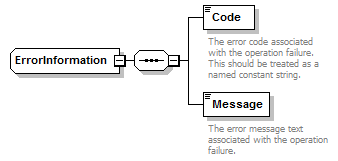 |
| namespace | http://nphase.com/unifiedwebservice/v2 |
| children | Code Message |
| source | <xs:complexType name="ErrorInformation"> <xs:sequence> <xs:element name="Code" type="xs:string"> <xs:annotation> <xs:documentation>The error code associated with the operation failure. This should be treated as a named constant string.</xs:documentation> </xs:annotation> </xs:element> <xs:element name="Message" type="xs:string"> <xs:annotation> <xs:documentation>The error message text associated with the operation failure.</xs:documentation> </xs:annotation> </xs:element> </xs:sequence> </xs:complexType> |
element ErrorInformation/Code
| diagram |  |
||
| namespace | http://nphase.com/unifiedwebservice/v2 | ||
| type | xs:string | ||
| properties |
|
||
| annotation |
|
||
| source | <xs:element name="Code" type="xs:string"> <xs:annotation> <xs:documentation>The error code associated with the operation failure. This should be treated as a named constant string.</xs:documentation> </xs:annotation> </xs:element> |
element ErrorInformation/Message
| diagram |  |
||
| namespace | http://nphase.com/unifiedwebservice/v2 | ||
| type | xs:string | ||
| properties |
|
||
| annotation |
|
||
| source | <xs:element name="Message" type="xs:string"> <xs:annotation> <xs:documentation>The error message text associated with the operation failure.</xs:documentation> </xs:annotation> </xs:element> |
complexType ExtendedAttributesObj
| diagram | 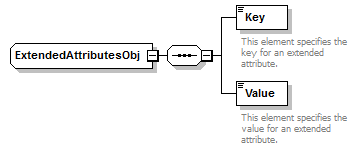 |
||
| namespace | http://nphase.com/unifiedwebservice/v2 | ||
| children | Key Value | ||
| used by |
|
||
| source | <xs:complexType name="ExtendedAttributesObj"> <xs:sequence> <xs:element name="Key" type="xs:string" nillable="true"> <xs:annotation> <xs:documentation>This element specifies the key for an extended attribute.</xs:documentation> </xs:annotation> </xs:element> <xs:element name="Value" type="xs:string" nillable="true"> <xs:annotation> <xs:documentation>This element specifies the value for an extended attribute.</xs:documentation> </xs:annotation> </xs:element> </xs:sequence> </xs:complexType> |
element ExtendedAttributesObj/Key
| diagram |  |
||||
| namespace | http://nphase.com/unifiedwebservice/v2 | ||||
| type | xs:string | ||||
| properties |
|
||||
| annotation |
|
||||
| source | <xs:element name="Key" type="xs:string" nillable="true"> <xs:annotation> <xs:documentation>This element specifies the key for an extended attribute.</xs:documentation> </xs:annotation> </xs:element> |
element ExtendedAttributesObj/Value
| diagram |  |
||||
| namespace | http://nphase.com/unifiedwebservice/v2 | ||||
| type | xs:string | ||||
| properties |
|
||||
| annotation |
|
||||
| source | <xs:element name="Value" type="xs:string" nillable="true"> <xs:annotation> <xs:documentation>This element specifies the value for an extended attribute.</xs:documentation> </xs:annotation> </xs:element> |
complexType FeatureCode
| diagram |  |
| namespace | http://nphase.com/unifiedwebservice/v2 |
| children | Code Description |
| source | <xs:complexType name="FeatureCode"> <xs:sequence> <xs:element name="Code" type="xs:string" nillable="true"/> <xs:element name="Description" type="xs:string" nillable="true"/> </xs:sequence> </xs:complexType> |
element FeatureCode/Code
| diagram |  |
||||
| namespace | http://nphase.com/unifiedwebservice/v2 | ||||
| type | xs:string | ||||
| properties |
|
||||
| source | <xs:element name="Code" type="xs:string" nillable="true"/> |
element FeatureCode/Description
| diagram |  |
||||
| namespace | http://nphase.com/unifiedwebservice/v2 | ||||
| type | xs:string | ||||
| properties |
|
||||
| source | <xs:element name="Description" type="xs:string" nillable="true"/> |
complexType InclusiveDateTimeRange
| diagram | 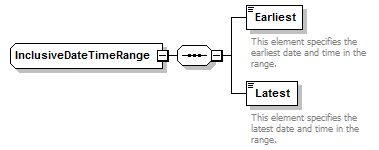 |
| namespace | http://nphase.com/unifiedwebservice/v2 |
| children | Earliest Latest |
| source | <xs:complexType name="InclusiveDateTimeRange"> <xs:sequence> <xs:element name="Earliest" type="xs:dateTime"> <xs:annotation> <xs:documentation>This element specifies the earliest date and time in the range.</xs:documentation> </xs:annotation> </xs:element> <xs:element name="Latest" type="xs:dateTime"> <xs:annotation> <xs:documentation>This element specifies the latest date and time in the range.</xs:documentation> </xs:annotation> </xs:element> </xs:sequence> </xs:complexType> |
element InclusiveDateTimeRange/Earliest
| diagram |  |
||
| namespace | http://nphase.com/unifiedwebservice/v2 | ||
| type | xs:dateTime | ||
| properties |
|
||
| annotation |
|
||
| source | <xs:element name="Earliest" type="xs:dateTime"> <xs:annotation> <xs:documentation>This element specifies the earliest date and time in the range.</xs:documentation> </xs:annotation> </xs:element> |
element InclusiveDateTimeRange/Latest
| diagram |  |
||
| namespace | http://nphase.com/unifiedwebservice/v2 | ||
| type | xs:dateTime | ||
| properties |
|
||
| annotation |
|
||
| source | <xs:element name="Latest" type="xs:dateTime"> <xs:annotation> <xs:documentation>This element specifies the latest date and time in the range.</xs:documentation> </xs:annotation> </xs:element> |
complexType PrimaryPlaceOfUse
| diagram |  |
| namespace | http://nphase.com/unifiedwebservice/v2 |
| children | CustomerName Address |
| source | <xs:complexType name="PrimaryPlaceOfUse"> <xs:sequence> <xs:element name="CustomerName" type="PrimaryPlaceOfUseCustomerName" nillable="true"/> <xs:element name="Address" type="PrimaryPlaceOfUseAddress" nillable="true"/> </xs:sequence> </xs:complexType> |
element PrimaryPlaceOfUse/CustomerName
| diagram | 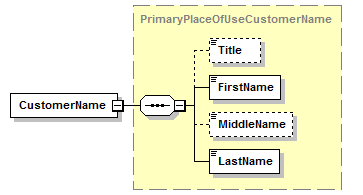 |
||||
| namespace | http://nphase.com/unifiedwebservice/v2 | ||||
| type | PrimaryPlaceOfUseCustomerName | ||||
| properties |
|
||||
| children | Title FirstName MiddleName LastName | ||||
| source | <xs:element name="CustomerName" type="PrimaryPlaceOfUseCustomerName" nillable="true"/> |
element PrimaryPlaceOfUse/Address
| diagram | 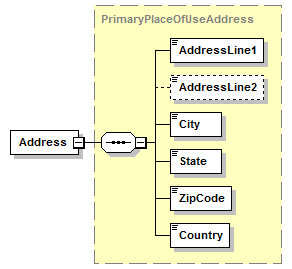 |
||||
| namespace | http://nphase.com/unifiedwebservice/v2 | ||||
| type | PrimaryPlaceOfUseAddress | ||||
| properties |
|
||||
| children | AddressLine1 AddressLine2 City State ZipCode Country | ||||
| source | <xs:element name="Address" type="PrimaryPlaceOfUseAddress" nillable="true"/> |
complexType PrimaryPlaceOfUseAddress
| diagram | 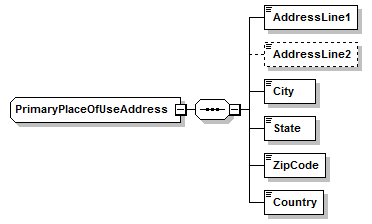 |
||
| namespace | http://nphase.com/unifiedwebservice/v2 | ||
| children | AddressLine1 AddressLine2 City State ZipCode Country | ||
| used by |
|
||
| source | <xs:complexType name="PrimaryPlaceOfUseAddress"> <xs:sequence> <xs:element name="AddressLine1" type="xs:string" nillable="true"/> <xs:element name="AddressLine2" type="xs:string" nillable="true" minOccurs="0"/> <xs:element name="City" type="xs:string" nillable="true"/> <xs:element name="State" type="xs:string" nillable="true"/> <xs:element name="ZipCode" type="xs:string" nillable="true"/> <xs:element name="Country" type="xs:string" nillable="true"/> </xs:sequence> </xs:complexType> |
element PrimaryPlaceOfUseAddress/AddressLine1
| diagram |  |
||||
| namespace | http://nphase.com/unifiedwebservice/v2 | ||||
| type | xs:string | ||||
| properties |
|
||||
| source | <xs:element name="AddressLine1" type="xs:string" nillable="true"/> |
element PrimaryPlaceOfUseAddress/AddressLine2
| diagram |  |
||||||||
| namespace | http://nphase.com/unifiedwebservice/v2 | ||||||||
| type | xs:string | ||||||||
| properties |
|
||||||||
| source | <xs:element name="AddressLine2" type="xs:string" nillable="true" minOccurs="0"/> |
element PrimaryPlaceOfUseAddress/City
| diagram |  |
||||
| namespace | http://nphase.com/unifiedwebservice/v2 | ||||
| type | xs:string | ||||
| properties |
|
||||
| source | <xs:element name="City" type="xs:string" nillable="true"/> |
element PrimaryPlaceOfUseAddress/State
| diagram |  |
||||
| namespace | http://nphase.com/unifiedwebservice/v2 | ||||
| type | xs:string | ||||
| properties |
|
||||
| source | <xs:element name="State" type="xs:string" nillable="true"/> |
element PrimaryPlaceOfUseAddress/ZipCode
| diagram |  |
||||
| namespace | http://nphase.com/unifiedwebservice/v2 | ||||
| type | xs:string | ||||
| properties |
|
||||
| source | <xs:element name="ZipCode" type="xs:string" nillable="true"/> |
element PrimaryPlaceOfUseAddress/Country
| diagram |  |
||||
| namespace | http://nphase.com/unifiedwebservice/v2 | ||||
| type | xs:string | ||||
| properties |
|
||||
| source | <xs:element name="Country" type="xs:string" nillable="true"/> |
complexType PrimaryPlaceOfUseCustomerName
| diagram | 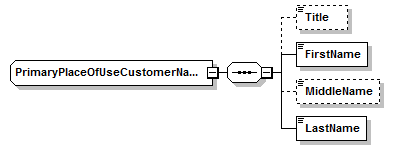 |
||
| namespace | http://nphase.com/unifiedwebservice/v2 | ||
| children | Title FirstName MiddleName LastName | ||
| used by |
|
||
| source | <xs:complexType name="PrimaryPlaceOfUseCustomerName"> <xs:sequence> <xs:element name="Title" type="xs:string" nillable="true" minOccurs="0"/> <xs:element name="FirstName" type="xs:string" nillable="true"/> <xs:element name="MiddleName" type="xs:string" nillable="true" minOccurs="0"/> <xs:element name="LastName" type="xs:string" nillable="true"/> </xs:sequence> </xs:complexType> |
element PrimaryPlaceOfUseCustomerName/Title
| diagram |  |
||||||||
| namespace | http://nphase.com/unifiedwebservice/v2 | ||||||||
| type | xs:string | ||||||||
| properties |
|
||||||||
| source | <xs:element name="Title" type="xs:string" nillable="true" minOccurs="0"/> |
element PrimaryPlaceOfUseCustomerName/FirstName
| diagram |  |
||||
| namespace | http://nphase.com/unifiedwebservice/v2 | ||||
| type | xs:string | ||||
| properties |
|
||||
| source | <xs:element name="FirstName" type="xs:string" nillable="true"/> |
element PrimaryPlaceOfUseCustomerName/MiddleName
| diagram |  |
||||||||
| namespace | http://nphase.com/unifiedwebservice/v2 | ||||||||
| type | xs:string | ||||||||
| properties |
|
||||||||
| source | <xs:element name="MiddleName" type="xs:string" nillable="true" minOccurs="0"/> |
element PrimaryPlaceOfUseCustomerName/LastName
| diagram |  |
||||
| namespace | http://nphase.com/unifiedwebservice/v2 | ||||
| type | xs:string | ||||
| properties |
|
||||
| source | <xs:element name="LastName" type="xs:string" nillable="true"/> |
complexType Time
| diagram | 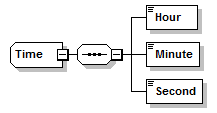 |
||
| namespace | http://nphase.com/unifiedwebservice/v2 | ||
| children | Hour Minute Second | ||
| used by |
|
||
| source | <xs:complexType name="Time"> <xs:sequence> <xs:element name="Hour" type="xs:unsignedByte"/> <xs:element name="Minute" type="xs:unsignedByte"/> <xs:element name="Second" type="xs:unsignedByte"/> </xs:sequence> </xs:complexType> |
element Time/Hour
| diagram |  |
||
| namespace | http://nphase.com/unifiedwebservice/v2 | ||
| type | xs:unsignedByte | ||
| properties |
|
||
| source | <xs:element name="Hour" type="xs:unsignedByte"/> |
element Time/Minute
| diagram |  |
||
| namespace | http://nphase.com/unifiedwebservice/v2 | ||
| type | xs:unsignedByte | ||
| properties |
|
||
| source | <xs:element name="Minute" type="xs:unsignedByte"/> |
element Time/Second
| diagram |  |
||
| namespace | http://nphase.com/unifiedwebservice/v2 | ||
| type | xs:unsignedByte | ||
| properties |
|
||
| source | <xs:element name="Second" type="xs:unsignedByte"/> |
complexType TimeRange
| diagram |  |
| namespace | http://nphase.com/unifiedwebservice/v2 |
| children | Start End |
| source | <xs:complexType name="TimeRange"> <xs:sequence> <xs:element name="Start" type="xs:dateTime"/> <xs:element name="End" type="xs:dateTime"/> </xs:sequence> </xs:complexType> |
element TimeRange/Start
| diagram |  |
||
| namespace | http://nphase.com/unifiedwebservice/v2 | ||
| type | xs:dateTime | ||
| properties |
|
||
| source | <xs:element name="Start" type="xs:dateTime"/> |
element TimeRange/End
| diagram |  |
||
| namespace | http://nphase.com/unifiedwebservice/v2 | ||
| type | xs:dateTime | ||
| properties |
|
||
| source | <xs:element name="End" type="xs:dateTime"/> |
complexType TimeRangePerDay
| diagram |  |
| namespace | http://nphase.com/unifiedwebservice/v2 |
| children | Start End |
| source | <xs:complexType name="TimeRangePerDay"> <xs:sequence> <xs:element name="Start" type="Time"/> <xs:element name="End" type="Time"/> </xs:sequence> </xs:complexType> |
element TimeRangePerDay/Start
| diagram |  |
||
| namespace | http://nphase.com/unifiedwebservice/v2 | ||
| type | Time | ||
| properties |
|
||
| children | Hour Minute Second | ||
| source | <xs:element name="Start" type="Time"/> |
element TimeRangePerDay/End
| diagram |  |
||
| namespace | http://nphase.com/unifiedwebservice/v2 | ||
| type | Time | ||
| properties |
|
||
| children | Hour Minute Second | ||
| source | <xs:element name="End" type="Time"/> |
XML Schema documentation generated by XMLSpy Schema Editor http://www.altova.com/xmlspy